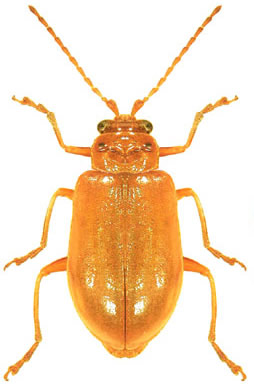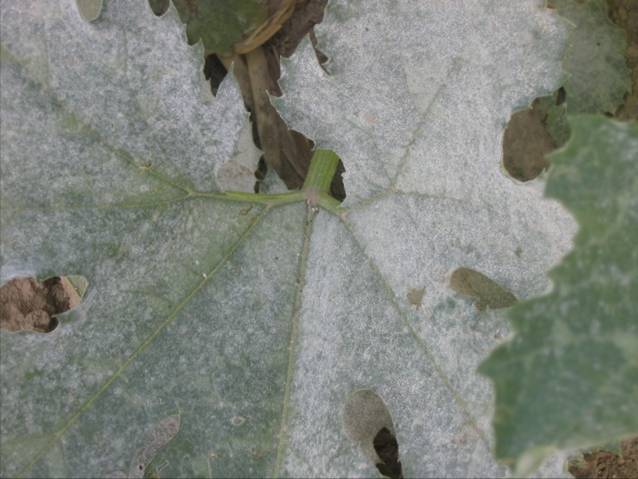|
Pests
Red pumpkin beetle: Aulacophora foveicollis
Pumpkin beetles attack the watermelon at the seedling stage by making holes in cotyledonary
leaves. As a result the seedlings in the young stage die.

Control: Spraying carbaryl (4g/litre) during the seedling stage effectively controls
the pest.
Aphids: Aphis sp.
Aphids damage the plants by sucking the leaf sap. In young stage, cotyledonary leaves
crinkle and in severe cases the plants wither. The leaves of fully grown vines turn
yellow and plant loses its vigour.
Control: The aphids can be easily controlled by spraying malathion (0.1 %) or rogor
(0.1-0.2 %) sufficiently early before the attack becomes severe.
Fruit fly: Dacus cucurbitae and
D. dorsalis
The fruit fly maggots causes severe damage to young developing fruits. The adult
fly lays eggs in the flowers. The eggs hatch into maggots, which feed inside the
fruits and causes rotting. The fly attack is severe, especially after summer rains
when the humidity is high.
Control: There is no direct control of maggots because they are inside the developing
fruits. The affected fruits should be regularly pinched off and buried in a pit.
Spraying carbaryl or malathion 0.15% suspension containing sugar/jaggery @ 10g per
litre water at the time of flowering partially check the fly incidence.
Mites
Nymphs and adult mites suck cell sap. White patches appear on affected leaves, which
become mottled, turn brown and fall. The pest attains serious proportions during
summer. Different stages of mite are found in colonies covered by white-silky webs
on lower surface of leaves.
Control: Acaricides like dicofol (0.05 %) and wettable sulphur (0.3 %) gives effective
control of mites. Cutting and burning of severely infested plant parts reduces further
multiplication of mites.
Diseases
Powdery mildew: Sphaerotheca fuliginea
Symptoms start as white powdery residue on the upper leaf surface. On the lower
surface of the leaves, circular patches or spots appear. In severe cases, these
spread, coalesce and cover both the surfaces of the leaves and spread also to the
petioles, stem, etc. Severely attacked leaves become brown and shrivelled; and defoliation
may occur. Fruits of the affected plants do not develop fully and remain small.

Control: Carbendazim (1ml/litre) or karathane (0.5 ml/litre) is sprayed immediately
after the appearance of the disease. Repeat the spray 2-3 times at an interval of
15 days.
Anthracnose: Colletotrichum sp.
High humidity and moist weather favour the development of the disease. Symptoms
appear on the leaf as black spots, which later turn pink in colour. In case of severe
infection, the disease spread to the developing fruit.
Control: Repeated sprayings at 5-7 days interval with dithane M 45 (0.2 %) effectively
controls the disease.
Fusarium wilt: Fusarium oxysporum
f. sp. niveum
Initially the plants show temporary wilting symptoms, which become permanent and
progressive, affecting more vines. The leaves of the affected plants show yellowing,
loose turgidity and show drooping symptoms. Eventually, the plant dies. In older
plants, leaves wilt suddenly and vascular bundles in the collar region become yellow
or brown.
Control: Three sprays of karathane (6g/10 litres) or bavistin (1g/litre) immediately
on appearance of initial symptoms at 5-6 days interval controls the disease. Leaves
of fully grown vines should be thoroughly drenched during spraying.
Downey mildew: Pseudoperonospora cubensis
The disease is first seen as yellow angular spots on the upper surface of the leaves.
Under conditions of high humidity, whitish powdery growth appears on the lower surface
of the leaves. The disease spreads rapidly killing the plant quickly through rapid
defoliation.

Control: Excellent control of this disease can be achieved with ridomil (1.5 g/litre
of water), which must always be used simultaneously with a protectant fungicide
such as mancozeb (0.2%) to prevent the development of resistant strains.
Top
|